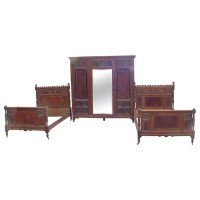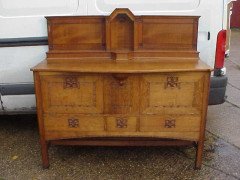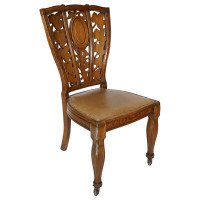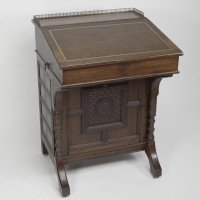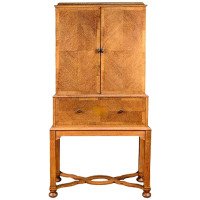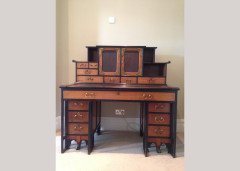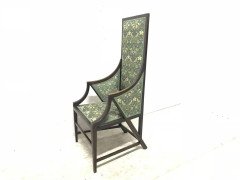Bruce Talbert for Gillows. An extremely rare Gothic Revival walnut and Amboyna Bedroom suite
POA
An extremely rare Gothic Revival walnut and Amboyna Bedroom suite designed by Bruce Talbert and made by Gillows of Lancaster consisting of a treble wardrobe, 2 x 3'6" double beds and 2 x matching bedside cupboards. The treble wardrobe with full length bevelled mirror to the centre door with central carved rosette to the top flanked by 2 carved panels depicting 16 carved floret's with further carved rosettes to the side doors and to the lower parts each carved with a different floret on Ebonised and Gilt backgrounds, the central panels of Amboyna framed with ebonised strips and further smaller rosettes to each corner, the front sides with further floret's and carved tramline details, the cornice with dental moulding and all on Egyptian revival feet, the doors opening to reveal hanging space to the left hand side, Linen slides to the upper double right hand side (not shown but all original and all there) and drawers below. The beds and bedside cabinets with conforming identical details. corresponds exactly to ones made by Gillow for the Midland Grand Hotel at St Pancras. See Arts and Crafts Furniture by John Andrews Printed by The Antique Collectors Club ISBN 1-85149-483-9 page 37 for a comparable sideboard. Wardrobe Height 82 1/2" 208cm, Width of cornice 81 1/2" 208cm, Depth of cornice 24", Beds Height of head board 51", Height of foot board 32", Width 41" 124cm, Bedside cupboards Height 35" 85cm, Width 15" 35cm, Depth 15" 35cm. Circa 1880's. Bruce James Talbert originally trained as a carver then an architect, he became an influential and very successful furniture designer. He served an apprenticeship in Dundee and had his own carving business for two years where he learnt the skills to apply carved details to furniture and then joined the architectural offices of Charles Edward. In 1856 he moved to Glasgow. And worked for the architects W. N. Tait and Campbell Douglas. He moved to Manchester in the early 1860s, where he gained employment with the cabinetmakers Doveston, Bird and Hull, which was short lived, then moving to to Coventry gaining work with Skidmore’s Art Manufactures. In 1863 he won the competition to design the masthead for ‘The Building News’ and in the mid 1860s moved to London, where he started designing furniture for Holland and Sons. His ‘Pericles’ Gothic sideboard was displayed on their stand at the Paris Exposition Universelle of 1867 where it was Grand Prix winner. It was at this point that his most prolific period began and also when he started designing furniture for Gillows of Lancaster from 1868. in the same year he published his very influential first book ‘Gothic Forms Applied to Furniture, Metal Work and Decoration for Domestic Purposes’, which he dedicated to George Edmund Street. This was followed in 1876 by ‘Examples of Ancient and Modern Furniture, Metalwork, Tapestries and Modern Furniture’ and in 1881 by ‘Fashionable Furniture’. Other companies he designed for were Marsh, Jones and Cribb, Jackson and Graham and a short time, was a partner with Daniel Cottier. He designed textiles for Templeton’s, Warner’s, Cowlishaw and Barbour and Miller; carpet designs for Templeton’s and Brinton and Co.; and his wallpaper designs were printed by Jeffrey and Co. He also designed church metalwork and furniture for Cox and Sons, cast iron for the Colebrookdale Co., Nichol and Co, Barbone and Miller and Cowlishaw. In 1869 Talbert returned to London working as prolific and successful freelance commercial designer and decorator. I'm sure you know this already, but you don't mention it in the description so I thought I'd just say that your bedroom suite (or certainly its wardrobe) corresponds exactly to ones made by Gillow for the Midland Grand Hotel at St Pancras. There was an article on the subject in The Magazine Antiques a few years ago. Thanks for this info from Nicholas Williams.


